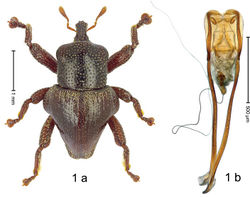Trigonopterus abnormis
| Notice: | This page is derived from the original publication listed below, whose author(s) should always be credited. Further contributors may edit and improve the content of this page and, consequently, need to be credited as well (see page history). Any assessment of factual correctness requires a careful review of the original article as well as of subsequent contributions.
If you are uncertain whether your planned contribution is correct or not, we suggest that you use the associated discussion page instead of editing the page directly. This page should be cited as follows (rationale):
Citation formats to copy and paste
BibTeX: @article{Riedel2019ZooKeys, RIS/ Endnote: TY - JOUR Wikipedia/ Citizendium: <ref name="Riedel2019ZooKeys">{{Citation See also the citation download page at the journal. |
Ordo: Coleoptera
Familia: Curculionidae
Genus: Trigonopterus
Name
Trigonopterus abnormis Riedel sp. n. – Wikispecies link – ZooBank link – Pensoft Profile
Diagnostic description
Holotype, male (Fig. 1a). Length 3.00 mm. Color of antennae and legs ferruginous; remainder black. Body shape dominated by laterally protruding humeri; in dorsal aspect with marked constriction between pronotum and elytron; in profile dorsally convex. Rostrum in basal 1/2 dorsally with median ridge and pair of submedian ridges; anteriorly coarsely punctate; furrows with rows of erect subclavate scales; epistome with transverse ridge and submedian pair of denticles. Pronotum anteriorly with lateral flanges; disk subquadrate, coarsely punctate; interspaces subglabrous. Elytra with humeri markedly protruding; densely irregularly punctate with small punctures, near base punctures larger; striae indistinct, some marked by hairlines; sutural interval in basal 1/3 swollen, densely irregularly punctate; swollen humeri densely coarsely punctate; subbasally with yellowish almond-shaped scales; subapically with sparse narrow scales. Femora with anteroventral ridge distinct, crenate, in meso- and metafemur ending with denticle; anterior surface punctate-reticulate, each puncture with a scale, dorsally scales erect and subclavate. Metafemur with dorsoposterior edge serrate; subapically with stridulatory patch. Metatibia with posterior surface densely setose in subapical 1/2, with erect scales in basal 1/2. Abdominal ventrites 1–2 concave, subglabrous. Abdominal ventrite 5 flat, densely coarsely punctate. Penis (Fig. 1b) with body differentiated into hyaline lateral flanges and sclerotized inner frame; sides of body weakly diverging; apex with median constriction; apodemes 3.1 × as long as body of penis; transfer apparatus complex, asymmetrical; ductus ejaculatorius without distinct bulbus. Intraspecific variation. Length 2.20–3.00 mm. Female rostrum dorsally flattened, with ridges less distinct; epistome indistinct. Female pronotum without lateral flanges. Female elytra without swollen humeri.
Material examined
Holotype (MZB): ARC3142 (EMBL # LN884964), SE-Sulawesi Prov., Kendari, road from Wawotobi to Lasolo, 03°44.142'S 122°13.670'E, 482 m, sifted, 17-IV-2013. Paratypes (SMNK, MZB): 5 exx, ARC3143 (GenBank # MK260434), ARC3144 (GenBank # MK260436), ARC3145 (GenBank # MK260435), same data as holotype.
Distribution
SE-Sulawesi Prov. (Kendari). Elevation ca. 480 m.
Biology
In leaf litter of lowland forest.
Etymology
This epithet is based on the Latin adjective abnormis, -e (abnormal) and refers to the species´ unusual body shape.
Notes
Trigonopterus abnormis sp. n. was coded as “Trigonopterus sp. 481”.
Original Description
- Riedel, A; Narakusumo, R; 2019: One hundred and three new species of Trigonopterus weevils from Sulawesi ZooKeys, (828): 1-153. doi
Images
|
